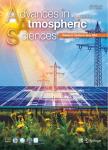The Predictability of a Squall Line in South China on 23 April 2007
The Predictability of a Squall Line in South China on 23 April 2007作者机构:Laboratory for Climate and Ocean-Atmosphere StudiesDepartment of Atmospheric and Oceanic Sciences School of PhysicsPeking University
出 版 物:《Advances in Atmospheric Sciences》 (大气科学进展(英文版))
年 卷 期:2013年第30卷第2期
页 面:485-502页
核心收录:
学科分类:07[理学] 070601[理学-气象学] 0706[理学-大气科学]
基 金:supported by National Key Basic Research Program of China (Grant No. 2013CB430104) National Natural Science Foundation (Grant Nos. NSFC41075031and NSFC40921160380) the R&D Special Fund for Public Welfare Industry (meteorology) (Grant No.GYHY200906025)
主 题:squall line predictability South China ensemble moisture
摘 要:This study investigated the predictability of a squall line associated with a quasi-stationary front on 23 April 2007 in South China through deterministic and probabilistic forecasts. Our results show that the squallline simulation was very sensitive to model error from horizontal resolution and uncertainties in physical parameterization schemes. At least a 10-km grid size was necessary to decently capture this squall line. The simulated squall line with a grid size of 4.5 km was most sensitive to long-wave radiation parameterization schemes relative to other physical schemes such as microphysics and planetary boundary layer. For a grid size from 20 to 5 km, a cumulus parameterization scheme degraded the squall-line simulation (relative to turning it off), with a more severe degradation to grid size -10 km than 〉10 km. The sensitivity of the squall-line simulation to initial error was investigated through ensemble forecast. The performance of the ensemble simulation of the squall line was very sensitive to the initial error. Approximately 15% of the ensemble members decently captured the evolution of the squall line, 25% failed, and 60% dislocated the squall line. Using different combinations of physical parameterization schemes for different members can improve the probabilistic forecast. The lead time of this case was only a few hours. Error growth was clearly associated with moist convection development. A linear improvement in the performance of the squall line simulation was observed when the initial error was decreased gradually, with the largest contribution from initial moisture field.



